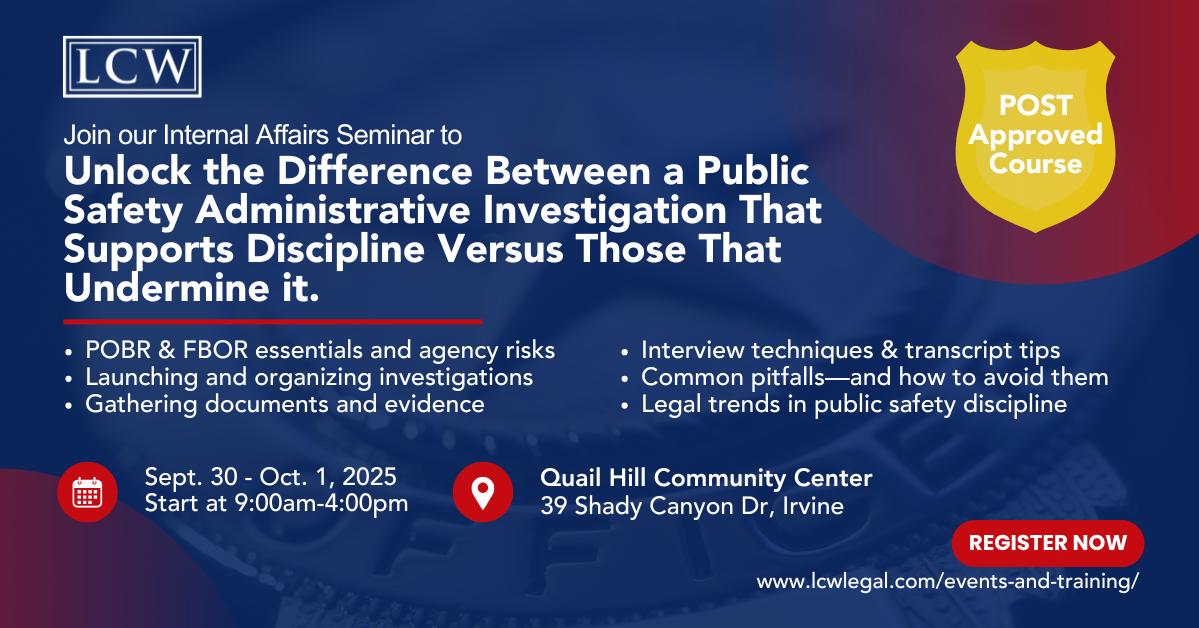




Cynthia
Ronni Cuccia


Police officers were pursuing a vehicle a possible burglary suspect was driving. The officers had no information to suggest the suspect was armed. One police officer was some distance away from the pursuit, but as the suspect’s vehicle approached, that officer exited his vehicle, and fired 18 rounds into the suspect’s vehicle. Neither the suspect nor any other individual was hit or injured, and the pursuit continued.
The police department investigated the officer’s conduct, and found that it violated numerous department policies. The surveillance video footage did not corroborate the officer’s testimony or justification for his actions.
The police department terminated the officer, and the officer appealed the termination to the civil service commission. Through written briefing and a hearing, Jeff convinced the commission that the officer’s policy violations and willful disregard for safety constituted grounds for discipline. The police officer then appealed to the city council. After consideration during a closed session, the city council too upheld the officer’s termination and civil service commission’s ruling.
A County’s correctional sergeant conducted a “nighttime” firearms qualification for a group of sworn officers at approximately 1:00 p.m.—well before dusk—despite his knowledge that this qualification must be conducted under low-light conditions. The sergeant completed and distributed qualification forms to the officers that indicated: the tests occurred at 5:00 p.m.; and that one officer had qualified with a shotgun, even though that officer had not. The County’s Sheriff’s Department investigated and terminated the sergeant. The sergeant appealed.
The sergeant admitted during the hearing that he knowingly entered false information on the forms, but claimed he was intimidated by a higher-ranking officer who needed the nighttime qualification. The sergeant retained the originals of the forms and made no effort to disclose the falsification until his supervisors questioned him the following day.
The hearing officer decided that the County met its burden of proving that sergeant was intentionally dishonest with the purpose of inducing reliance, including by distributing the falsified forms to sworn personnel. The decision also found the sergeant’s explanations and claimed intent to later disclose the issue were not credible. The penalty of termination was reasonable given the seriousness of the misconduct, the sergeant’s supervisory rank, and his failure to take responsibility. The hearing officer concluded that the dishonesty undermined public trust and internal integrity, and justified dismissal under the governing Memorandum of Understanding.
Associate
A City decided to terminate the employment of a parks and landscape inspector based on a pattern of workplace misconduct that included multiple incidents of unprofessional, aggressive, or abusive behavior toward City employees, members of the public, and Chamber of Commerce staff. Witnesses said the inspector made verbal threats, yelled profanities, and intimidated people at public events. In one incident, he allegedly challenged a coworker to a fight. An outside investigation substantiated many of these claims. The inspector also failed to report that a coworker made sexual comments in violation of the City’s harassment prevention policy.
The inspector appealed. He argued that his termination was unjustified because he had a good work history, received no prior discipline, and the allegations were either exaggerated or the result of coworker animosity. His representative argued that the City tolerated foul language from other employees.
Joung and Allison convinced the hearing officer that termination was warranted due to the seriousness and repeated nature of the misconduct, the inspector’s lack of accountability, and the risk of recurrence. The hearing officer credited the thorough investigation the outside investigator conducted, and agreed that the misconduct violated City policies, including the workplace violence prevention policy, the harassment policy, and standards of professional conduct. The hearing officer found that that progressive discipline was not required under these circumstances and concluded that termination was justified and appropriate.
To learn more about our program, please visit our website below or contact Anna Sanzone-Ortiz 310.981.2051 or asanzone-ortiz@lcwlegal.com.
Lilian Carranza, then a captain in the Los Angeles Police Department (LAPD or Department), learned that a photo of a topless woman, which was falsely said to be her, was circulating among LAPD personnel. One of her subordinates told her: 1) he had seen on-duty officers looking at the photo on a cellphone and making lewd comments about Carranza; and 2) he had heard officers were talking about the photo everywhere he went. Carranza asked the Department to notify personnel that the photo was not of her, and to order they stop sharing it.
The Department investigated. The investigation found that an unknown Department employee, while on or off-duty, circulated a photograph of a nude woman throughout the Department and indicated it was Carranza. The investigation identified 10 to 13 people who saw the photo and four separate incidents of people viewing or hearing about the photo. Carranza received a letter from the LAPD that said appropriate penalties would be imposed but did not disclose further details, citing confidentiality reasons. Carranza later learned no officers were disciplined.
The Department did not notify personnel that the photo was not Carranza, nor order that employees stop sharing it.
Carranza sued the City of Los Angeles, asserting a single cause of action for hostile work environment due to sexual harassment under the Fair Employment and Housing Act (FEHA). A jury found in Carranza’s favor, and determined that the LAPD failed to take immediate and appropriate corrective action despite that it knew of the conduct. It awarded Carranza $4 million in noneconomic damages.
The City appealed. The City claimed that there was insubstantial evidence that the harassment was sufficiently severe or pervasive to alter the conditions of Carranza’s employment and create an abusive work environment.
The California Court of Appeal rejected the City’s claim. The Court determined that substantial evidence supported the jury’s determination that Carranza endured severe or pervasive harassment that altered the conditions of her workplace, based on Carranza’s secondhand knowledge that the photo was widely circulating. Carranza understood that the photo circulated for some length of time and involved “dozens if not hundreds” of officers, both identified and unknown, throughout the LAPD.
Plus, despite Carranza’s repeated requests, the Department did not order LAPD officers to stop sharing the photo, advise them that it was not Carranza in the photo, or discipline anyone who distributed the photo. The fact that LAPD allowed the distribution to continue unchecked supported not only Carranza claims that LAPD’s response to the harassment was not sufficient, but also demonstrated the pervasiveness and severity of the harassment itself and the impact on Carranza’s work environment.
Carranza v. City of Los Angeles, 111 Cal.App.5th 388 (2025).
A defendant charged with murder filed a Pitchess motion to get Brady information from the confidential personnel files of six Los Angeles County Sheriff’s deputies. Brady refers to a 1963 U.S. Supreme Court case that found that a criminal defendant’s right to due process requires a prosecutor to disclose evidence or information that would prove the innocence of the defendant or would enable the defense to more effectively impeach the credibility of government witnesses.
In this case, the trial court found the defendant’s Pitchess motion established good cause for the court to review the peace officer records. The trial court determined the personnel files of four of the six deputies contained Brady material. The Los Angeles Sheriff’s Department (LASD) contended that the initial disclosure in Pitchess is limited to the name and the contact information of the reporting parties and witnesses. The trial court agreed with LASD and denied the request for the Brady material itself. Instead, the trial court ordered disclosure of the names, addresses, and telephone numbers of the individuals who had witnessed or complained of the conduct of the officers that was at issue in the case.
The defendant then filed a Brady motion seeking Brady discovery. In the Brady motion, the defendant argued he was entitled to the actual Brady evidence, as opposed to a single document listing the name and contact information of each complainant as is commonly provided in response to a Pitchess motion. (Penal Code sections 832.7 and 832.8; and Evidence Code sections 1043 through 1045.)
The trial court still refused to give the defendant the actual Brady information. The trial court found that the case authorities did not specify the scope of the information to be turned over once a court determines that Brady material is present in an officer’s file. The
trial court concluded that it should not turn over any more than what is required by Pitchess - the names and contact information for complainants and witnesses. The man then filed a petition for writ of mandate in the California Court of Appeal to order the trial court to provide the Brady material.
The California Court of Appeal found that the trial court should have ordered the LASD to disclose all Brady material in the four deputies’ personnel files, including documents and any audio-video materials.
This case is a primer on the discovery of confidential peace officer records. Although the Court found that a party seeking Brady material must comply with the Pitchess motion procedures, this case defines the substantive differences between a Pitchess motion and a Brady motion, including: 1) what a party must show to justify an in camera review on each type of motion; and 2) what information the court must order disclosed on a successful motion.
First, the Court found that a criminal defendant must show good cause in order to allow a court to review peace officer files. This is a low burden on both motions. On a Pitchess motion, the defendant must show that the information is material to the pending criminal case; and that the defendant has a reasonable belief that the agency has the type of information sought. Pitchess motions generally seek information about past complaints by third parties of excessive force, violence, dishonesty, or the filing of false police reports.
The criminal defendant’s burden on a Brady motion is even lower. All a defendant must do is describe the Brady-tip or Brady bank alert that it received, together with some explanation of how the officer’s credibility might be relevant to the proceeding. No allegations of officer misconduct in the defendant’s case are required. Second, once good cause has been shown, the scope of the disclosures for a classic Pitchess motion versus a Brady motion is also different. On a Pitchess motion,
material that is potentially relevant includes records that touch on the type of misconduct that the defendant has alleged the officer committed in dealing with the defendant. This would include complaints that the police agency has deemed unfounded. Given this low bar and the potential to sweep in materials with only minimal relevance, limiting initial disclosures to names and contact information for complainants and witnesses makes sense in a classic Pitchess context.
Conversely, when a court determines that an officer’s personnel file contains Brady information, by definition, the relevance of the material is not “minimal.” Rather, the court has concluded that the information has the potential to affect the outcome of the trial. The limitations on disclosure in the Pitchess statute (Evidence Code section 1045(b) & (c)) do not apply to Brady information. Therefore, the practice of refusing to disclose the actual records is not applicable to Brady material.
Schneider v. Superior Court (Los Angeles County Sheriff’s Department), 111 Cal.App.5th 613 (2025).
In April 2023, California Highway Patrol (CHP) attempted to serve a search warrant on a man in a Roseville City Park. A shootout broke out between the man, CHP, and officers from the Roseville Police Department (the Department), who arrived after the shooting commenced. CHP officers, the man, and two hostages all had gunshot wounds.
A reporter from Sacramento Television Stations Inc. (Sac TV) made a California Public Records Act request that the Department release footage from the body worn cameras of the involved officers. The Department argued that its officers discharged fire arms only during a three-minute window of time. The Department released four 39-second clips body camera footage, some without sound, and audio clips of radio communications. A second Sac TV reporter responded, requesting the full footage from all body worn cameras and dash cameras at the scene of the incident. The Department maintained that it had released everything it was legally required to disclose, and asserted that it was only required to release footage of a narrow, critical incident, and not a larger criminal event.
Sac TV filed for a writ of mandate for access to all body worn camera footage from the time officers were dispatched to the scene to about one hour later. Although the superior court acknowledged that broad disclosure law required a recording of a shooting to include more than just the seconds before and after, the fact of City’s active investigation rendered it unnecessary for the court to determine precisely how much additional disclosure would have been required in this dispute. Accordingly, the superior court denied Sac TV’s mandate petition seeking an order compelling the City to disclose more recordings.
Sac TV then filed a petition for writ of mandate in the California Court of Appeal. The Court concluded that the superior court correctly determined that statute required more disclosure than the City provided. But, the Court found that the superior court’s “active investigation” finding was not supported by substantial evidence. Thus, the Court sent the case back to the superior court to conduct further proceedings, including an in camera review of the recordings, to determine the extent of additional disclosure required.
Sacramento Television Stations Inc. v. Superior Court of Placer County, 2025 Cal.App, LEXIS 406.
In 2020, Open Vallejo, a local news outlet, published an article alleging a secretive group of officers within the Vallejo Police Department (Department) were bending a point of their star-shaped badge after each time they used lethal force in the line of duty. The Department retained a third party to investigate. The investigator found that the practice had occurred, but that no officer had violated the Department’s use of force policy.
The American Civil Liberties Union of Northern California (ACLU) filed a request for records related to the investigation, including the written investigation report, under the California Public Records Act (CPRA).
The Department released some records but maintained that the bulk of the materials sought—including the investigative report—were confidential peace officer personnel records that were exempt from public disclosure under Pitchess statutes. Pursuant to the parties’ stipulation, the superior court heard and ruled
on the ACLU’s Pitchess motion that sought materials relevant to its CPRA arguments. Thereafter, the ACLU filed a petition for writ of mandate in the superior court challenging the sufficiency of the Department’s CPRA response.
The superior court ordered disclosure of portions of the investigative report and related materials. The materials to be disclosed included the materials the court had ordered disclosed following the Pitchess hearing, with redactions to all identifying information pertaining to officers, witnesses and their families.
Both parties sought writ review by the California Court of Appeal. The ACLU argued that the records must be disclosed under amendments made to the Pitchess statutes in 2018 through the enactment of Senate Bill No. 1421 and, specifically, the amendment requiring the disclosure of records “relating to the report, investigation, or findings” of “[a]n incident involving the discharge of a firearm at a person by a peace officer.” The City argued that the records at issue were confidential because they did not “necessarily and promptly” follow any specific police shooting.
The Court found that the crux of dispute was whether the investigative report and related documents on badge bending were subject to public disclosure as records “relating to” the report, investigation, or findings of an

incident involving the discharge of a firearm by a peace officer. The Court considered the meaning of the phrase “relating to” and found that it should be interpreted broadly. The Court also found that the legislative history of the law was concerned with transparency regarding an officer’s use of significant force. The Court held that any report, investigation, or finding of an incident involving an officer involved shooting is a public record that must be disclosed.
The Court sent the case back to the superior court to deal with the secondary issue of whether officer names should be redacted from the records. The Court noted that the superior court ruled that officer names must be redacted because the names were part and parcel of what it deemed were confidential officer personnel records. The Court rejected that part of the superior court’s ruling as erroneous because the records sought were not confidential personnel records, but were instead publicly disclosable personnel records. But the Court determined it could not make any final pronouncement on the redaction issue because the parties had not addressed all the relevant facts and legal issues in the superior court. The Court provided a lengthy analysis of the relevant cases to guide the superior court and the parties on remand.
City of Vallejo v. Superior Court of Solano County. 112 Cal. App.5th 565 (2025).
To view this article and the most recent LCW attorney-authored articles, please visit: www.lcwlegal.com/news
• Partner Steven M. Berliner and Associate John Z. LaCrosse authored an article in Western City titled “Three Developments at CalPERS That City Leaders Need to Know About.” The spotlight proposed legislation that could undo key PEPRA reforms—potentially spiking agency costs and reigniting union negotiations. A must-read for public employers navigating complex retirement laws.
• Co-Managing Partners J. Scott Tiedemann and Melanie Chaney were recently featured in “The Lawyer’s Edge” podcast where they speak about their proven approach to leadership succession planning, the secret behind the firm’s stability and growth and creating a culture that centers around its core values. Listen to the full podcast here: https:// thelawyersedge.com/podcast/tips-for-seamless-leadership-succession/
• Recently published in Bloomberg Law, LCW Partner James Oldendorph and Associate Emanuala Tala authored an article titled “California Law Enforcement Grappling With Crime and Transparency,” emphasizing that California’s efforts at police reform require law enforcement agencies to carefully track the reporting and hiring requirements going into effect.
California Labor Code section 1102.5 prohibits public employers from retaliating against whistleblowing employees, and allows an employee who wins in court to recover attorney’s fees. Employers have an affirmative defense in section 1102.6 if the employer can prove that the alleged retaliatory conduct “would have occurred for legitimate, independent reasons” had the employee not been a whistleblower. This type of defense is commonly known as a “same-decision defense.”
D’Andre Lampkin, a deputy at the Los Angeles County Sheriff’s Department, told his supervisor about a contentious traffic stop involving a former deputy. Thereafter, Lampkin encountered a variety of adverse actions, including a search of his residence, a suspension, and the termination of his medical benefits.
Lampkin sued the County for whistleblower retaliation in violation of section 1102.5. After trial, the jury found that section 1102.5 protected Lampkin from retaliation, and that Lampkin’s complaint was a factor in the Department’s actions against Lampkin. The jury also found the Department would have made the same decisions anyway, for independent and legitimate reasons. The jury awarded Lampkin no damages.
Lampkin then filed a motion for an order declaring him the prevailing party who was entitled to a fee award. Lampkin claimed he was entitled to fees under a prior Court of Appeal case - Harris v. City of Santa Monica. That case held that a same-decision defense does not preclude a fee award in a Fair Employment and Housing Act (FEHA) case. The trial court granted Lampkin’s motion and awarded Lampkin $400,000 in attorney’s fees. The County appealed.
The California Court of Appeal reversed the fee award. The Court distinguished Harris on several grounds. First, FEHA provides discretionary authority to award fees to a “prevailing party,” while section 1102.5(j) only permits fees for one who brings a “successful action.” Also, section 1102.6 provides comprehensive procedural rules specific to whistleblower claims, including the same-decision defense, and does not contain any language permitting fees once that defense is established. The Court held that an employee’s whistleblower action is not “successful” under section 1102.5 if the employer has established the samedecision defense and the employee obtains no relief.
Lampkin v. County of Los Angeles, 2025 Cal.App. LEXIS 434.

Kheloud Allos worked for Poway Unified School District (PUSD). When the COVID-19 pandemic began in 2020 she began working remotely. After in-person operations resumed, Allos requested to continue working from home. Initially, she based her request on her desire to protect her elderly mother. Later, she claimed her own medical vulnerabilities made in-person work risky. She claimed that her past reaction to a vaccine meant she could not safely take the COVID-19 vaccine.
PUSD responded with a series of interactive meetings—six in total over nearly two years—to explore accommodations. The district offered Allos a private office and various hybrid work arrangements. Ultimately, Allos agreed to a hybrid schedule and later announced her retirement. She then filed a lawsuit against PUSD under California’s Fair Employment and Housing Act (FEHA) and various Labor Code provisions, claiming disability discrimination, failure to accommodate, retaliation, and associational discrimination (related to caring for her disabled mother), among others.
PUSD filed a motion for summary judgment asserting Allos’s claims were barred by Government Code section 855.4, which provides immunity to public entitles for decisions related to preventing disease or controlling its spread. The court agreed, holding that PUSD’s decision to end remote work and require in-person attendance was a discretionary act protected under section 855.4. The court also found that Allos’s disability claims failed. The court noted that PUSD had multiple interactive meetings with Allos and provided various accommodations.
The California Court of Appeal affirmed the trial court’s judgment. The Court agreed that section 855.4 provided immunity to PUSD for its decisions related to COVID-19. The court also found that Allos failed to present evidence of a qualifying disability under FEHA, since her alleged vaccine allergy and other health conditions did not constitute a disability. The Court held that PUSD’s interactive process and accommodations were reasonable and that no adverse employment action had occurred because Allos voluntarily retired. The
Court concluded that Allos’s claims for associational discrimination, retaliation, and Labor Code violations had no merit.
Kheloud Allos v. Poway Unified School District, 2025 Cal.App. LEXIS 431.
The U.S. Supreme Court affirmed the decision of the Court of Appeals for the Eleventh Circuit, which held that retired employees are not “qualified individuals” under Title I of the American with Disabilities Act (ADA), and therefore are not entitled to sue their former employer for post-employment benefits. Ninth Circuit precedent was already aligned with this U.S. Supreme Court decision.
The plaintiff was Karyn Stanley, a firefighter who was diagnosed with Parkinson’s disease. In 2018, Stanley retired after her disease left her incapable of performing essential job duties. After retiring, Stanley learned that in 2003, the City changed its policy to only provide retirement benefits to disabled retirees for 24 months following their retirement. Stanley sued in 2020.
The ADA prohibits employers from adopting and implementing policies or practices that discriminate against “qualified individuals” based on the individual’s disability. Title I of the ADA defines a “qualified individual” to mean someone with a disability who, with or without reasonable accommodation, can perform the essential functions of the job that they hold or desire. The Eleventh Circuit Court of Appeals held that Stanley could not sue in 2020 because, at that point, she was retired from the City and therefore not a “qualified individual” under the ADA.
The U.S. Supreme Court affirmed, holding that Stanley was not a “qualified individual” under the ADA when she filed suit because she was neither a qualified applicant for employment nor a current employee at the time of the alleged discrimination.
Stanley v. City of Sanford, 145 S.Ct. 2058 (2025).
The U.S. Supreme Court unanimously prohibited the use of a higher standard for reverse discrimination claims. The Court ruled that members of a majority group are not required to show “background circumstances” to support allegations of reverse discrimination. The ruling rejects the decision of the U.S. Court of Appeals for the Sixth Circuit, which held that plaintiff Marlean Ames, a heterosexual woman, needed evidence of “background circumstances” to support her reverse discrimination allegations. Ninth Circuit precedent was already aligned with this U.S. Supreme Court decision.
Ames, was a former employee for the Department of Youth Services (Department). Her lawsuit alleged that the Department discriminated against her based on her sexual orientation in violation of Title VII of the Civil Rights Act of 1964.
In a 2018 performance evaluation, Ames’s supervisor rated Ames as meeting or exceeding expectations in numerous categories as a Program Administrator. In 2019, Ames unsuccessfully applied for a new position as Bureau Chief. Instead, the Department decision makers
hired a gay woman. Soon after, the Department demoted Ames to her previously-held secretary position, at a much lower pay rate. The Department then hired a gay man to replace Ames as Program Administrator.
Ames alleged that the Department had discriminated against her based on her heterosexual orientation. The District Court granted the Department’s summary judgment motion, holding that because Ames was a member of a majority group, she was required to show “background circumstances” to support her reverse discrimination allegations. The Court of Appeals affirmed the District Court decision.
The U.S. Supreme Court’s opinion vacated the Sixth Circuit’s ruling and remanded the case. The opinion holds that majority group plaintiffs do not have to show “background circumstances” to establish VII discrimination. Such a rule is contrary to the text of Title VII and longstanding Supreme Court precedent. In addition, the decision makes clear that majority group plaintiffs do not have a higher burden to show discrimination than a minority group plaintiff.
Ames v. Ohio Department of Youth Services, 145 S.Ct .1540 (2025).








Kim Catacutan is an experienced human resources professional currently serving as a Classification & Compensation Consultant in the Sacramento office of Liebert Cassidy Whitmore.
Olivia Davis is an Associate in the San Diego office of Liebert Cassidy Whitmore, where she supports clients in all aspects of labor and employment law.
Sandra I. Herrera is Senior Counsel in the Los Angeles office of Liebert Cassidy Whitmore, where she provides legal counsel to clients on a wide range of transactional, business and facilities, and corporate governance matters.
Suneeta H. Israni is an Associate in the Los Angeles office of Liebert Cassidy Whitmore where she represents public sector clients in labor, employment, and litigation matters.
Tavi Kessler is an Associate in the Los Angeles office of Liebert Cassidy Whitmore, where she represents clients in labor, employment, and education law matters.
Jessica Lee is an Associate at Liebert Cassidy Whitmore, where she advises clients on labor and employment matters, including compliance, investigations, and workplace policies.



Hoaithi “Y.T.” Nguyen is Senior Counsel in Liebert Cassidy Whitmore’s San Francisco Office. Y.T. has over 15 years of experience in employment litigation, labor relations and investigations.
Ethan Wicklund is an Associate in the San Francisco office of Liebert Cassidy Whitmore, where he represents clients in labor and employment matters.

Members of Liebert Cassidy Whitmore’s employment relations consortiums may speak directly to an LCW attorney free of charge regarding questions that are not related to ongoing legal matters that LCW is handling for the agency, or that do not require in-depth research, document review, or written opinions. Consortium call questions run the gamut of topics, from leaves of absence to employment applications, disciplinary concerns and more. This feature describes an interesting consortium call and how the question was answered. We will protect the confidentiality of client communications with LCW attorneys by changing or omitting details.
Can our agency require employees to use California Paid Sick Leave in increments of half a day (4 hours)?
No. Under Labor Code Section 246(k), the employee determines how much paid sick leave to use. An employer may set a reasonable minimum increment which cannot exceed two hours. The four-hour minimum the agency is proposing exceeds the two-hour minimum the law allows.

Whether you are looking to impress your colleagues or just want to learn more about the law, LCW has your back! Use and share these fun legal facts about various topics in public safety.
• Assembly Bill 992, currently moving through the California Legislature, would require that starting in 2031, incoming officers must obtain a policing certificate, associate degree or bachelor’s degree, within 36 months of graduating from a police academy. It also creates a law enforcement recruitment task force to identify and recruit candidates for law enforcement agencies throughout the state.
• The number of vehicles stolen in California statewide has dropped by 13% from 2023 to 2024 – the first year-over-year decrease since 2019. Of those vehicles stolen, nearly 92% of cars, trucks and SUVs were successfully recovered.
• The California Department of Civil Rights has published a victim’s rights notice that employers must distribute: 1) at the time of hire; 2) once per year to all employees; 3) upon request; and 4) whenever an employee discloses that they or a family member has been a victim of a qualifying act of violence. (Gov. Code section 12945.8 (k)(1).) The notice can be downloaded here: https:// calcivilrights.ca.gov/wp-content/uploads/sites/32/2025/07/Survivors-Right-to-Time-Off_ English-B.pdf The FAQ can be downloaded here: https://calcivilrights.ca.gov/wp-content/uploads/ sites/32/2025/06/Survivors-Right-to-Time-Off-FAQs_English.pdf





